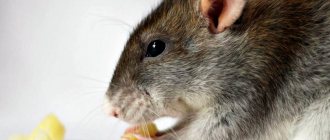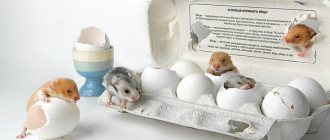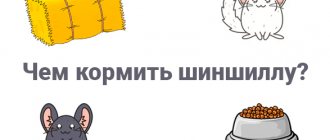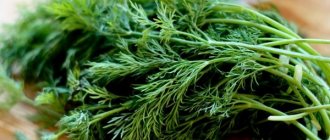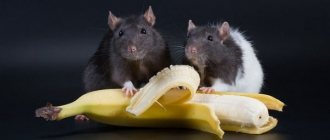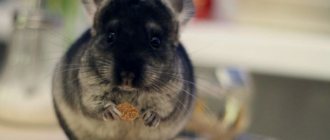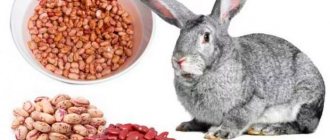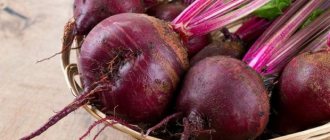The rat is an amazing pet that everyone in the household loves, so they try to prolong its life as much as possible. The basis for a pet’s good health is proper living conditions and a nutritious diet.
Not everyone thinks about what to feed a rat correctly. It is generally accepted that it is omnivorous and indestructible; it can easily eat even a piece of cardboard or sawdust. In most situations, rat owners go in two ways: either they feed the rat like a hamster, or they give away table scraps. Both of these approaches are wrong.
In fact, feeding a rat correctly is not difficult. You need to choose only healthy foods and give her the right amount of proteins, fats and carbohydrates.
Prohibited Products
Any prepared food, especially fried or spicy food, is prohibited for rats; canned food; sweet; alcoholic drinks; sweet drinks.
It is also undesirable to feed your pet from the owner's table: the food sold in specialized stores is already balanced and includes all the necessary vitamins. If you give your pet food from the table, the animal may refuse its food. Afterwards, it will be very difficult to wean the animal off junk food.
If you want to pamper your pet with fruits or vegetables, it is very important that they are in season, otherwise there is a risk of poisoning from harmful pesticides that are used for quick growing and long-term storage.
Grains and cereals - which ones should you avoid?
Grains form the main diet of rats, but it is necessary to know which grains can be fed and which cannot.
- Wheat is allowed for rats, but requires supplementation with other types of grains. Very high in calories. Wheat can be diluted with rice, buckwheat, corn and other grains.
- Buckwheat is considered dietary, has few calories, and can be added to the diet of rats.
- Corn, on the contrary, is high in calories; it is advisable to give it less often than others and as an additive to other grains.
- Oats - can cause fermentation, so it can be given, but in small quantities.
- Rice is considered to have little nutritional value, so it is advisable to feed either wild or brown rice.
- Semolina does not contain anything beneficial for the rat’s body, and veterinarians advise excluding it from the diet.
- Millet or barley - they can be given in the form of ready-made porridge for weakened animals, or for nursing offspring; adults can sometimes be given for variety.
Choosing food
The basis of a rat's diet is a grain mixture. You need to choose a trusted manufacturer who maintains balance when formulating feed. If you can’t find good ready-made food, it’s better to cook it yourself than to buy low-quality food, which consists of almost 80% oats. A complete diet should include oats, wheat, barley and rye.
It is better not to take food in a cardboard box, as it is stored in unsealed packaging, and if it was near chemicals, the rat can easily get poisoned. You only need to buy formulations in airtight packaging, and it is better to do this not in a regular supermarket, but in a specialized veterinary store.
You can buy not only grain mixture, but also granulated food. This food is similar in composition to regular grain food; it is purchased when the rat eats selectively, eating the most delicious food and leaving the grain untouched.
Vegetables and greens
Vegetables are very healthy and are allowed to be consumed daily, but in small quantities.
- Cabbage - any kind is undesirable for consumption, because... causes fermentation.
- Broccoli – can be given as an occasional treat.
- Radishes/turnips/radishes and some legumes (beans, lentils) cause increased discomfort due to gas formation, so their consumption is undesirable.
- Carrots/zucchini/pumpkin are very healthy, rich in vitamins, so their consumption is recommended.
- Eggplants/artichokes – only boiled ones are allowed; when cooking for an animal, adding salt or spices is not required.
- Cucumbers/beets – can cause stomach upsets in the form of diarrhea, so their consumption is undesirable.
- Potatoes have no value and are even prohibited in their raw form.
- Dill/parsley/celery, etc. are very beneficial for the digestion of rats, so it is advisable to add greens to their food daily.
- Tomato/sorrel – contain acid, consumption by rats is undesirable.
Nuts
Nuts are full of healthy fats, protein and fiber. They can be given to pets as a healthy treat. However, they should only be offered to rats in small quantities, as they contain too much fat. But the exception is chestnuts, which are low in fat and are considered the most suitable nut for rats.
We suggest adding several types of nuts to your pet's diet and alternating them - treating your rat to one of the types once a day. The following nuts are the best choices:
- Walnuts;
- Brazil nuts;
- Almond;
- Pecan;
- Pistachios.
Chestnuts are the only type of nut that can be given in large quantities and combined with other nuts.
Fruits
- Citrus fruits are prohibited for consumption, because may cause allergic reactions due to increased acidity. A piece of tangerine is allowed as a treat (sometimes).
- Forest/garden berries – the acidity of the berry must be taken into account. Cranberry is very useful, but you need to give it a little and watch the reaction.
- Pear – may cause fermentation, should be given occasionally.
- Plum – has a laxative effect, its use in the diet of rats is undesirable.
- Watermelon/melon – a small amount is allowed, but must be seasonal.
- Dried fruits can also provoke fermentation; they are given occasionally as a tasty treat.
It is important to know that eating seeds from berries and fruits is unacceptable; they are very harmful to animals and can cause poisoning.
Treats for rats
The rat is trainable; it can be taught to carry out several simple commands. But during training, you need to encourage the animal without harming it. And even without training, sometimes you want to pamper your pet with a tasty treat.
The main thing to remember is that the treat should not be sweet. Use nuts or seeds, give 1 piece to the paws a couple of times a week. This is a fatty and high-calorie product that can cause damage in large quantities. Nuts or seeds should not be fried or salted. You can give watermelon, pumpkin, sunflower, and sesame seeds.
Other incentive products may include:
- unsweetened wheat or corn flakes;
- biscuits;
- puffed rice or popcorn without additives;
- pasta;
- porridge.
You can take a stick and dip it in yogurt; the rat loves to lick it.
Milk products
All dairy products will be beneficial to your rat's health, but it is important to be aware of the possibility of a lactose allergy. It is advisable not to give pure milk, but other fermented milk can be given, but without fanaticism, you need to introduce new products little by little, observing the reaction. It is also undesirable to consume homemade sour cream/cream/cheese; often such products have a high fat content, which can cause digestive disorders.
Possible and useful:
- cottage cheese;
- fermented baked milk;
- pure yogurt;
- kefir.
Any fermented milk product should have no more fat than 4%. When it comes to low-fat products, it is advisable to choose non-perishable or children's dairy products.
Canning Potatoes ~ How to Press Canned Potatoes at Home
Canning potatoes at home is an easy way to preserve potatoes for long-term storage. Pre-cooked and ready-to-eat home canned potatoes make for a quick last minute meal straight from your home pantry.
Why can I have potatoes?
Although I can do anything at home, I admit that canning potatoes was not high on my list of priorities. Our basement is kept at a constant 50 degrees year-round, and while that's warm for a root cellar, we've had great success storing potatoes with minimal effort. Most years we stack about 200 pounds of potatoes in the fall, and with two potato-loving kids, at home this stock rarely survives until next June.
If they're so easy to store, why can potatoes? Many reasons!
Toggle navigation
- Recipes All recipes
- 30 minutes or less
- Less than 400 calories
- Food Recipes Breakfast and Brunch Lunch and Dinner
- World cuisine
- Seasonal Recipes Spring Summer Autumn Winter
- Vegetarian Recipes
- Meat recipes Beef Pork Chicken Lamb Duck
- Recipes for jacket potatoes
- Fish recipes Salmon White fish Shellfish
- Gluten Free Recipes
- Party Recipes Canapes Network
- Recipe videos
- Fluffy potatoes
- Best of the Basics
- Health and nutrition
.
Vitamin complex
For normal functioning of the body, rats need vitamins:
- To replenish vitamin A, rats eat milk, fishmeal and egg yolk. It affects reproduction and growth.
- Thiamine, or vitamin B1, is found in baker's yeast, dairy products and grass flour. It affects the functioning of the nervous system and the metabolism of carbohydrates in the animal’s body.
- Riboflavin, or vitamin B2, is found in grains and sprouts. He is responsible for the reproductive system.
- Pyridoxine, or vitamin B6, is found in grass flour, yeast and bran. Thanks to it, the risk of conjunctivitis and various skin diseases is reduced.
- Cobalamin, or vitamin B12, is found in fishmeal. Its source is also shellfish. Replenishes the lack of aminocarboxylic acids. Add to the diet in small quantities.
- Sources of ascorbic acid (vitamin C) include root vegetables, greens and fresh vegetables. It is given as a measure to prevent colds.
- Vitamin D is found in fish oil. It regulates the exchange of phosphorus and calcium in the body.
- Tocopherol, or vitamin E, is found in green food and sprouted grains. It is responsible for the functions of the reproductive system.
- The main sources of vitamin K are vegetable oil, green leafy vegetables, as well as liver and dairy products. Blood clotting depends on it.
If there is a lack of vitamins in your pet’s menu, you should buy a special vitamin complex in a pet store. To select vitamins for your animal, you need to contact a veterinarian. The selection depends on the individual characteristics of the domestic rat.
A properly designed nutrition menu will help kitty rats stay healthy for many years.
To choose food for a pet, the owner must pay attention to its characteristics. Rodents eat everything they are given, however, not all food is good for the animal.
English listening lesson on potatoes
POTATO LESSON
Try online quiz, reading, listening and grammar, spelling and vocabulary exercises for this lesson on Potatoes . Click on the links above or view the activities below this article:
Your browser does not support this audio player.
READ
| Potatoes are very important in my life. In fact, they are more important on my plate. I love potatoes. These are amazing vegetables. I can't count how many different ways to cook potatoes. Potatoes can be fried, baked, mashed, boiled, stewed and much more. Potatoes can be eaten both hot and cold - in the summer I really love chilled potato salad. Potatoes are also prepared differently in different countries. Indian cuisine is great if you love potatoes. My favorite Indian potato dish is called aloo gobi, which is potatoes and cauliflower cooked with delicious spices. One day I'll have to find out how healthy potatoes are. I know fried potatoes are high in cholesterol, but not sure about boiled ones. |
MY BOOK
VIEW SAMPLE
Share this lesson with friends and teachers. Click the @ icon below.
ACTIVITY
FILL IN THE GAP
Potatoes are very important in my life. Actually, it's more of a ______________________ dinner plate. I love potatoes. They ______________________. I can't count the number of ______________________ to cook potatoes. Potatoes can be ______________________, boiled, stewed, etc. You can also eat potatoes hot or cold - I ______________________ potato salad in the summer. Potatoes are also prepared differently in different countries. Indian cooking ______________________ potatoes. My favorite Indian potato dish is called aloo gobi - potatoes and cauliflower ______________________ spices. One day I will have to find out how healthy potatoes are. I know that fried potatoes are high in cholesterol, but I _______________________ potatoes.
CORRECT MISSING
Potatoes are very important in my life. In fact, they are more important on my plate. I love potatoes. This is vegetable ngiazam. I can't count how many different ways to cook potatoes. Potatoes can be fried, baked, cooked, boiled, stewed, etc. You can also eat potatoes hot or cold - I really like hcileld's potato salad at smuemr. Different countries have different ways of preparing potatoes. Indian cuisine is great if you love potatoes. My favorite Indian potato dish is called aloo gobi - potato and cauliflower ecookd in myumy pscsie . One day I will have to find out how healthy potatoes are. I know fried potatoes are high in cholesterol, but not sure about bdeoli potatoes.
UNDERSTAND THE WORDS
My potatoes are very important in life. Actually, on my plate they are more important, more important. I love potatoes. These are amazing vegetables. On the first day there cannot be different ways to cook potatoes. Potatoes can be fried, baked, mashed, boiled, stewed and much more. You can also eat potatoes hot or cold - in the summer I really love chilled potato salad. Potatoes are also prepared differently in different countries. Indian cuisine is great if you love potatoes. My favorite is an Indian potato dish called aloo gobi - and potatoes made with cauliflower with delicious spices. One day I will have to find out how healthy potatoes are. I know fried potatoes are cholesterol, but I'm not sure about boiled potatoes.
DISCUSSION (Write your questions)
| STUDENT A'S QUESTIONS (Do not show these to Student B) | |
| 1. | ________________________________________________________ |
| 2. | ________________________________________________________ |
| 3. | ________________________________________________________ |
| 4. | ________________________________________________________ |
| 5. | ________________________________________________________ |
| 6. | ________________________________________________________ |
| STUDENT B QUESTIONS (Do not show these to Student A) | |
| 1. | ________________________________________________________ |
| 2. | ________________________________________________________ |
| 3. | ________________________________________________________ |
| 4. | ________________________________________________________ |
| 5. | ________________________________________________________ |
| 6. | ________________________________________________________ |
SURVEY OF POTATO STUDENTS
Write five GOOD questions about potatoes on the table. Do this in pairs. Each student must write the questions on their own piece of paper.
When you are finished, interview other students. Write down their answers.
| STUDENT 1 _____________ | STUDENT 2 _____________ | STUDENT 3 _____________ | |
| IN 1. | |||
| Q.2. | |||
| Q.3. | |||
| AT 4. | |||
| Q.5. | |||
- Now go back to your original partner, share and communicate what you learned. Change partners often.
- Give mini-presentations to other groups about your findings.
LETTER
Write about potatoes in 10 minutes. Show your partner your paper. Correct each other's work.
______________________________________________________________________________
______________________________________________________________________________
______________________________________________________________________________
______________________________________________________________________________
______________________________________________________________________________
______________________________________________________________________________
______________________________________________________________________________
______________________________________________________________________________
______________________________________________________________________________
______________________________________________________________________________
______________________________________________________________________________
______________________________________________________________________________
______________________________________________________________________________
______________________________________________________________________________
______________________________________________________________________________
______________________________________________________________________________
HOMEWORK
1.EXPANSION OF THE WORD:
Choose a few words from the text. Use a dictionary or Google search box (or other search engine) to create more associations/combinations of each word.
2. INFORMATION ON THE INTERNET:
Search the Internet for more information about potatoes. Discuss what you discover with your partner(s) in the next lesson.
3. MAGAZINE ARTICLE:
Write a magazine article about potatoes. Read what you wrote to your classmates in the next lesson. Give each other feedback on your articles.
4. POTATO POSTER
Make a poster about potatoes. Show it to your classmates next lesson. Give each other feedback on your posters.
5. MY POTATO LESSON:
Make your own English lesson on potatoes. Make sure there is something to do. Find good things to do online. When finished, teach the class/another group.
6. EXCHANGE ON THE INTERNET:
Use your blog, wiki, Facebook page, MySpace page, Twitter thread, Del-icio-us/StumbleUpon account, or any other social media tool to get opinions on potatoes. Share your findings with the class.
ANSWERS
Check your answers in the article at the top of this page.
.
What should a rodent not eat?
There are products
, the presence of which in a rat’s diet is extremely undesirable. It is not recommended to give beets in any form to your pet, as this fruit can cause diarrhea in the rodent. Eating grapes can cause increased gas formation in the rat's intestines, so this fruit should not be given to the animal. Also, the rat should not be fed spinach, products containing soy and cocoa.
It is not recommended to give your rodent any boiled cereals, since their consumption can lead to the animal gaining excess weight. If you want to pamper your pet with porridge, then pour boiling water over the cereal, let it sit, cool, and only then give it to the rat.
It should be remembered that some plant foods can even kill an animal, and in this case we are talking about poisonous indoor plants. If you have flowers at home such as potted stools, dieffenbachia, begonia, cyclamen and azalea, then you need to be especially careful to ensure that the rat does not approach these plants.
It is not advisable to give your rat watermelon and melon, especially if these are early fruits. Store-bought melons may contain large amounts of nitrates, the consumption of which can result in the death of the rodent. Therefore the animal can eat
only homemade fruits and vegetables.
It should be taken into account that eating spoiled food can negatively affect the health of the rat, so the cage where the pet lives must be cleaned regularly.
If the animal has any problems
with health, then it should be immediately shown to a veterinarian, and not practice independent treatment of the rodent. The latter can lead to worsening health problems for your pet.
Got a new pet in your home? It's time to find out what to feed your rat, what food you can give it and what is strictly forbidden, what you can treat it to occasionally, and what it can eat without any restrictions. Although rats are not particularly picky about food, you cannot feed them “just anything.” Their diet should be balanced and food properly prepared.
What to feed a little rat
A mother rat feeds her offspring with milk. However, there are times when she does not want to do this. In this case, responsibility for the life of the offspring will fall on the shoulders of the animal owner. To feed baby rats, you can purchase a lactating female at a pet store or feed the babies yourself.
To feed babies, you can use a pet milk replacer. Dry soy baby formula diluted with a small amount of goat's milk or condensed milk is also perfect.
Important! Liquid formula can be stored in the refrigerator for no longer than 12 hours.
The milk mixture will need to be warmed up a little. To feed your offspring, it is better to use an insulin syringe with an internal catheter at the tip. You can also take a pacifier made from pieces of cotton fabric.
After each meal, you should pour boiling water over the items. To avoid the development of enteritis in young animals, it is worth giving small rats a course of Biovestin.
Below you can find detailed information regarding the principle of feeding animals by week:
- In the first 7 days of a rodent's life, it is worth feeding them every 120 minutes. liquid diluted milk formula. Closer to the 7th day of life, it is worth diversifying the menu with milk formula, to which a small amount of dry ground grain feed has been added;
- in the second week, the mixture for rodents can be diluted to a consistency that will resemble liquid sour cream. You will need to drink the mixture every 3-4 hours;
- in the third week of life, you can pour the food mixed with the mixture into a bowl. From 23.00 to 6.00 you can not feed the offspring;
- At 4 weeks, animals can be switched to dry food. From the 30th day of life, rodents should be given food that is familiar to adults. If desired, rat pups can be fed milk until the end of the second month of life.
Babies will need to be given formula every 2 hours.
What menu should babies have? When choosing a diet for little rats over 4 weeks old, you should give preference to:
- dry grain;
- boiled chicken, turkey and fish fillets;
- cottage cheese;
- dill and cilantro;
- bananas;
- apples;
- wheat sprouts;
- oats;
- chicken egg yolks;
- boiled chicken and turkey liver.
Under no circumstances should children be allowed to indulge in:
- cucumbers;
- champignons;
- garlic and onions;
- tomatoes.
Note! When rat pups are fed milk by their mother, they can only be fed by the 21st day of life. It is best not to wean babies early from breastfeeding, which has a positive effect on strengthening the animal’s immunity.
Organizing the right diet for your beloved rodent is important; this will allow you to raise the animal healthy. It is important to give up the desire to pamper your four-legged friend with table scraps such as sweets and sausage, as this can provoke the development of various pathologies of internal organs.
